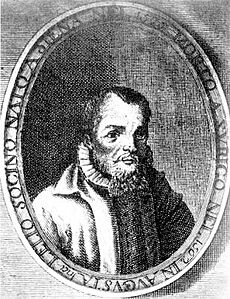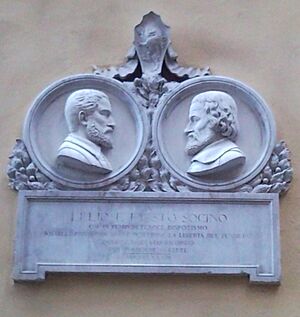Lelio Sozzini facts for kids

Lelio Francesco Maria Sozzini (born January 29, 1525 – died May 4, 1562) was an important Italian thinker and religious scholar during the Renaissance. He helped to start a Christian belief system called Socinianism. This belief system was different because it did not agree with the traditional idea of the Trinity (God as Father, Son, and Holy Spirit). Lelio worked with his nephew, Fausto Sozzini, to develop these ideas. Their teachings became popular among groups like the Polish Brethren and the Unitarian Church of Transylvania.
Contents
Lelio Sozzini's Life Story
Early Life and Education
Lelio Sozzini was born and grew up in Siena, a city in Italy. His family was well-known for being lawyers and scholars. Lelio was the sixth son of Mariano Sozzini the Younger. He studied law in Bologna, just like his father.
Lelio once told another scholar, Philipp Melanchthon, that he wanted to understand the original sources of law. This led him to study the Bible very deeply. Because of his Bible studies, he began to question some of the traditional teachings of the Catholic Church.
Travels and New Ideas
Lelio learned Hebrew, Arabic, and Greek languages. He wasn't a very hard student, but he was curious. His father gave him money, and when he was old enough, Lelio traveled to Venice. This city was a center for Protestant churches in Italy at the time.
Some stories say that Lelio was a key person in important religious meetings in Vicenza around 1546 and 1547. During this time, Lelio wanted to reform the Christian faith. He was very religious but also liked to think deeply about religious ideas.
In 1547, in Chiavenna, he met Paolo Ricci, a Christian mystic. Ricci's ideas were similar to those of the early Quakers. Lelio continued his religious travels across Europe. His family name and friendly personality helped him get a warm welcome in places like Switzerland, France, England, and the Netherlands.
Meeting Key Reformers
Lelio returned to Switzerland in late 1548. He visited important cities like Geneva, Basel, and Zürich. He stayed with famous scholars like Sebastian Münster and Konrad Pelikan.
From July 1550 to June 1551, he was in Wittenberg, Germany. He stayed with Melanchthon and then with Professor Johann Forster to improve his Hebrew skills. After Wittenberg, he went back to Zürich in late 1551. On his way, he visited Vienna, Prague, and Kraków.
Return to Italy and New Focus
In June 1552, Lelio went back to Italy, visiting Siena twice. At this time, people in Siena had more freedom of speech. This is when he met his young nephew, Fausto Sozzini.
Lelio was in Padua when Michael Servetus was executed in October 1553. Servetus was punished for his religious beliefs. This sad event made Lelio think even more about the doctrine of the Trinity.
He then traveled to Basel, Geneva, and Zürich in 1554, where he decided to live.
Discussions with Reformers
John Calvin, a famous Protestant leader, welcomed Lelio. Melanchthon also thought highly of him. Calvin noticed Lelio's tendency to think very deeply about religious ideas. Even though Calvin sometimes worried about Lelio's views, they remained friends.
Heinrich Bullinger was Lelio's closest friend among the Protestant Reformers. Lelio had many questions about religious topics. These included the Resurrection, predestination, how people are saved, the nature of repentance, and the sacraments. The execution of Servetus made him focus intensely on the idea of the Trinity.
In Geneva in April 1554, Lelio made some comments about the common Christian beliefs. Bullinger, at the request of others, asked Lelio about his faith. Lelio gave a clear statement of his beliefs in July 1555. He also stated that he reserved the right to keep asking questions and learning more.
Lelio also worked with Martino Muralto to bring Bernardino Ochino to Zürich as a pastor. Lelio and Ochino, who was also a deep thinker, greatly influenced each other as they discussed complex religious problems.
Later Life and Challenges
In 1555, Lelio turned 30. After his father died in 1556, Lelio faced money problems. His father had not left him anything in his will. With letters of introduction from people like Calvin, Lelio visited the courts in Vienna and Kraków in 1558. He hoped to get support to claim his family's estates in Florence.
Even though he was well-received outside Italy, Lelio could not do much at home. The Inquisition, a religious court, was watching his family. His brother Cornelio was put in prison in Rome. His brothers Celso and Camillo, and his nephew Fausto, were suspected of being Lutherans. Camillo had even fled from Siena.
In August 1559, Lelio returned to Zürich. He died there on May 4, 1562, at the home of Hans Wyss, a silk-weaver.
Lelio Sozzini's Legacy
There are no real pictures of Lelio Sozzini. Any images on medals are not genuine.
When Lelio died, his nephew Fausto was in Lyons. Fausto went to Zürich and gathered his uncle's papers. These papers did not contain much finished writing, but they had many notes.
Fausto often gave credit to his uncle Lelio for many of his own ideas. For example:
- Fausto learned the basic ideas for his theory of salvation from conversations with Lelio between 1552 and 1553.
- Fausto also got many ways of understanding specific Bible verses from Lelio. For instance, Lelio's idea that "In the Beginning" in John 1:1 meant "the beginning of the gospel" was used by Fausto. This helped Fausto argue against the idea that Jesus existed before he was born. Similarly, Lelio's interpretation of "Before Abraham was I am" in John 8:58 (which he thought related to Abraham's resurrection) was also used by Fausto.
Lelio Sozzini's Writings
Lelio Sozzini's surviving writings include:
- De sacramentis dissertatio (1555), which is about the sacrament. It has four parts.
- De resurrectione (a fragment from 1549?), about resurrection.
- Brevis explicatio in primum Iohannis caput (Short explanation of John 1). This was published after his death in 1568.
- Confessio Fidei (Zurich, July 1555), a statement of his faith.
He also had many letters in Latin and Italian. There are 53 letters from and to Sozzini, including those with Bullinger, Calvin, and B. Amerbach.


